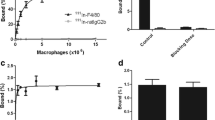Abstract
An indium 111-labelled mouse anti-rat T cell monoclonal antibody, MRC OX-19, was injected intravenously into rats to establish the usefulness of radiolabelled anti-lymphocyte antibodies in imaging lymphoid tissues. Antibody binding in vivo, measured by immunofluorescence analysis of cell suspensions made from lymphoid tissues, was detectable on lymphocytes in blood, spleen and lymph nodes. The extent of binding was time and antibody-dose dependent. Doses of antibody above 80 μg/kg body weight resulted in modulation, i.e. loss of CD 5 (T 1) molecules from the cell surface, although the cells remained in the circulation. Modulation was demonstrable within 2 h and for at least 24 h after a single injection of antibody. Intravenous injection of111In-MRC OX-19 resulted in levels of in vivo binding comparable with those seen with unlabelled antibody. Scintillation imaging showed early splenic localisation persisting over 48h, a more gradual localisation in the lymph nodes seen clearly at 24 h and a steady background. Comparison of the in vivo distribution of labelled antibody and111In-tropolone-labelled lymphocytes showed that both could be used for external imaging of lymphocytes by scintillation camera.
Similar content being viewed by others
References
Bevan DJ, Chisholm PM (1986) Co-expression of CD4 and CD8 molecules and de novo expression of MHC class II antigens on activated rat T cells. Immunology 59:621–625
Chisholm PM, Danpure HJ, Healey G, Osman S (1979) Cell damage resulting from the labeling of rat lymphocytes and HeLa S3 cells with111In oxine. J Nucl Med 20:1308–1311
Clevers H, Alarcon B, Wileman T, Terhorst C (1988) The T cell receptor/CD 3 complex: a dynamic protein ensemble. Ann Rev Immunol 6:629–662
Dallman MJ, Thomas ML, Green JR (1984) MRC OX-19: a monoclonal antibody that labels rat T lymphocytes and augments in vitro proliferation responses. Eur J Immunol 14:260–267
Goodwin DA, Meares CF (1985) Indium-111 labeled cells: new approaches and radiation dosimetry. In: Thakur ML (ed) Radiolabeled cellular blood elements: pathophysiology, techniques, and scintigraphic applications. NATO ASI Series, vol 88. Plenum, New York, pp 343–362
Goodwin DA, Bushberg JT, Doherty PW, (1978) Indium-111 labeled autologous platelets for location of vascular thrombi in humans. J Nucl Med 19:626–634
Hnatowich DJ, Layne WW, Childs RL (1982) The preparation and labeling of DTPA-coupled albumin. Int J Appl Radiat Isot 33:327–332
Houston LL, Nowinski RC, Bernstein ID (1980) Specific in vivo localisation of monoclonal antibodies directed against the Thy 1.1 antigen. J Immunol 125:837–843
Lavender JP, Goldman JM, Arnot RN, Thakur ML (1977) Kinetics of indium-111 labeled lymphocytes in normal subjects and patients with Hodgkin's disease. Br Med J 2:797–799
Lindmo T, Bunn PA Jr (1986) Determination of the true immunoreactive fraction of monoclonal antibodies after radiolabelling. Methods Enzymol 121: 678–691
Rannie GH, Thakur ML, Ford WL (1977) An experimental comparison of radioactive labels with potential application to lymphocyte migration studies in patients. Clin Exp Immunol 29:509–514
Russell P, Colvin RB, Cosimi AB (1984) Monoclonal antibodies for the diagnosis and treatment of transplant rejection. Ann Rev Med 35:63–81
Segal AW, Ensell J, Munro JM, Sarner M (1981) Indium-111 tagged leucocytes in the diagnosis of inflammatory bowel disease. Lancet ii: 230–232
Silvester DJ, Waters SL (1983) Dosimetry of radiolabelled blood cells. Int J Nucl Med Biol 10:141–144
Sprent J (1985) Migratory properties and radiosensitivity of lymphocytes. In: Thakur ML (ed) Radiolabeled cellular blood elements: pathophysiology, techniques, and scintigraphic applications. NATO ASI Series, vol 88. Plenum, New York, pp 31–50
Thakur ML, Lavender JP, Arnot RN, Silvester DJ, Segal AW (1977) Indium-111 labelled autologous leukocytes in man. J Nucl Med 18:1012–1019
Travers P, Bodmer WF (1984) Preparation and characterisation of monoclonal antibodies against placental alkaline phosphatase and other human trophoblast associated determinants. Int J Cancer 33:633–641
Williams AF, Galfre' G, Milstein C (1977) Analysis of cell surface by xenogeneic myeloma-hybrid antibodies: differentiation antigens of rats lymphocytes. Cell 12:663–673
Author information
Authors and Affiliations
Rights and permissions
About this article
Cite this article
Loutfi, I., Chisholm, P.M., Bevan, D. et al. In vivo imaging of rat lymphocytes with an indium 111-labelled anti-T cell monoclonal antibody: a comparison with indium 111-labelled lymphocytes. Eur J Nucl Med 16, 69–76 (1990). https://doi.org/10.1007/BF01465912
Received:
Revised:
Issue Date:
DOI: https://doi.org/10.1007/BF01465912




